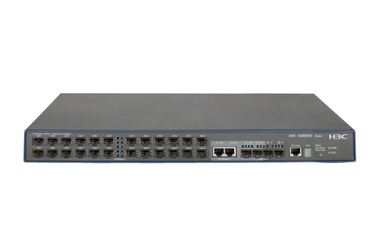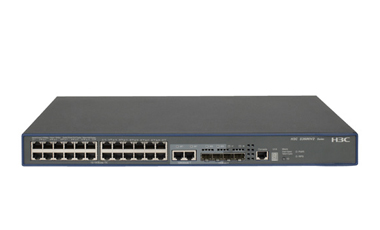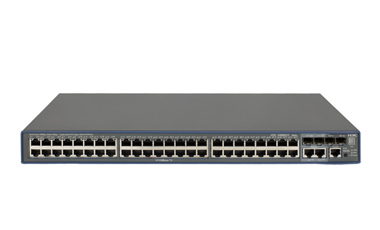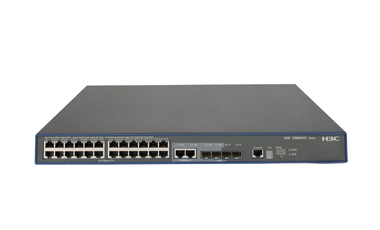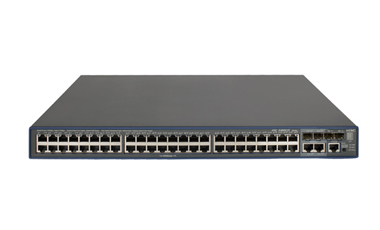- Products and Solutions
- Industry Solutions
- Services
- Support
- Training & Certification
- Partners
- About Us
- Contact Sales
- Become a Partner
-
 Login
Login
Country / Region
H3C S3600V2 Series Switches
The H3C S3600V2 SI/EI switch series deliver premium levels of intelligent and resilient performance, security, and reliability for robust switching at the enterprise network edge. The s3600 V2 SI/EI series switches consist of Layer 2/3 Fast Ethernet and PoE+ switches, with advanced features that can accommodate the most demanding applications. Secure, resilient connectivity and the latest traffic-prioritization technologies enhance converged networks. Designed for increased flexibility and scalability, H3C S3600V2 SI/EI series switches come with 24 or 48 10/100 ports, four active SFP-based Gigabit Ethernet ports for stacking and uplinks, and a 24-port 100BASE-FX switch with two or four Gigabit Ethernet SFP slots.
H3C S3600V2 series switches are a new generation of premier multi-layer switches that entirely fulfill the enterprise requirement for design and implementation of a unified, highly resilient network. One of the most important and innovative highlights of the S3600V2 series switches is the IRF (Intelligent Resilient Framework) technology which offers the highly efficient advantage of stackable technology. IRF enables network managers to build adaptable networks with high reliability, scalability and easy management. “Pay as you go” is the slogan of the S3600V2 series switches.
H3C S3600V2 series switches include the following models: S3600V2-28TP-SI, S3600V2-52TP-SI S3600V2-28F-EI, S3600V2-28TP-EI, S3600V2-52TP-EI S3600V2-28TP-PWR-EI, S3600V2-52TP-PWR-EI
The following contents are complex, and it is recommended to browse on PC.

Enter c.h3c.com.cn on the PC browser and operate according to the page to synchronize to the PC and continue browsing.
Continue by mobile
IPv6 features
Based on IPv4/IPv6 double stack and IPv6 over IPv4 tunnel(6 to 4 tunnel/ISATAP tunnel/ Automatic IPv4-compatible IPv6 tunnel manually configured tunnel), the H3C S3600V2 series switches can support various IPv6 features comprehensively, which makes them adapt well to IPv4-only, IPv6-only, and hybrid networks. This protects customer’s investment in network very well, and makes customer’s network can not only adapt present internet condition, but also meet future internet development requirements.
The S3600V2 EI series switches support abundant IPv6 routing protocols, including RIPng, ISISv6, OSPFV3, BGP4+for IPv6, support Neighbor Discovery Protocol (NDP), manage the interactions among neighboring nodes on the same link. Support Path Maximum Transport Unit(PMTU), the mechanism can determine an appropriate MTU for a link from the source node to destination node, this helps to utilize network resources more efficiently and to gain the optimal throughput.
Full wire-speed, multi-layer switching
The S3600V2 series switches offer L2/L3 wire-speed switching capability for all ports. The system offers 4 GE ports to meet the requirement of a single piece of equipment for multiple Gigabit uplinks and for access to the Gigabit server, thereby greatly increasing savings on equipment investment.
The hardware supports L3 wire-speed switching, and is able to identify and process the application traffic flows from L2~L4.
All ports have an independent data packet filter, and distinguish specific application flows for different management and control.
IRF Technology
Intelligent Resilient Framework (IRF) is an innovative resilient network technology that allows enterprise customers to design and implement Fast Ethernet core and aggregation that are adaptable, providing exceptional reliability, scalability and easy management. With IRF technology, the S3600V2 series switches can be interconnected together to behave as a single logical switching entity called a Distributed Fabric. From management and configuration perspectives, the Fabric appears as a single device, while from a performance perspective, each switch in the Distributed Fabric can make its own forwarding decisions, both at Layer 2 and Layer 3 for traffic that appears on its ports.
The IRF technology provides: DDM (Distributed Device Management), DRR (Distributed Resilient Routing) and DLA (Distributed Link Aggregation).
Distributed Device Management (DDM)
Distributed Device Management is the control system for IRF technology, responsible for distributing management and control information across the IRF Distributed Fabric.
Distributed Resilient Routing (DRR)
Distributed Resilient Routing, provided by Enhanced Image, is an advanced routing implementation that allows multiple interconnected switches in an IRF Distributed Fabric to behave as a single active routing entity.
Distributed Link Aggregation (DLA)
Distributed Link Aggregation, provided by Enhanced Image, allows networks and IRF Distributed Fabrics to be coordinated with switches at the edge of the network. DLA guarantees high levels of resilience since failure in one of the members of the Aggregated Link results in automatic redistribution of traffic across the remaining links.
PoE+ Supply Function
The S3600V2 EI series switches support PoE+ function for the LAN switching infrastructure, which provides power over a copper Ethernet cable to an endpoint (Powered Device).
The S3600V2 series switches provide up to 48 simultaneous full-powered PoE ports at 15.4W for maximum powered-device support, such as IP telephony and wireless LAN deployments. As PSE (Power Sourcing Equipment) devices, all S3600V2 series switches are 802.3af compliant PoE switches.
With PoE and Voice VLAN technology, these innovative switches can provide the perfect solution for a converged voice and data network.
High reliability
The S3600V2 series switches support STP/RSTP/ MSTP, greatly improving redundant back-up for links and fault tolerance capability, so the network can run with high levels of stability.
The S3600V2 series switches support the optional RPS (Redundant Power Supply, provided by Enhanced Image), thus improving the fault tolerance capability and normal network operation duration.
The S3600V2 series switches support VRRP (provided by Enhanced Image), and can build a VRRP back-up group with other L3 switches. In this way, a redundant route topological structure can be built so that when a fault occurs in guaranteeing communication continuity and reliability, network stability is maintained.
The S3600V2 series switches support the VRRP backup group port tracking function. As long as this function is enabled, customers can elect to track the link state of the master’s uplink port and decrease the priority of the switch when the port fails. This in turn triggers the new master to be determined in the backup group.
The S3600V2 series switches support ECMP (Equal Cost Multi-path Protocol, provided by Enhanced Image) routing, which can be used for load balance and routing redundancy.
Abundant QoS policies
The S3600V2 series switches support L2~L4 complex flow classification based on source MAC address、destination MAC address、VLAN、source IP address、destination IP address, ports and protocols.
The S3600V2 series switches support flexible queue scheduling algorithms, which can be set on the basis of port and queue at the same time. They support Strict Priority (SP), Weighted Round Robin(WRR), Weighted Fair Queuing (WFQ), SP+WRR, and SP+WFQ; 8 priority queues and 2 drop precedence; WRED congestion avoidance algorithm and port traffic shaping.
The S3600V2 series switches support Committed Access Rate (CAR) and limits the traffic speed at 64Kbit/s granularity.
u The S3600V2 series switches can configure the Priority for Protocol Packets. Each protocol packet has its own priority. Customers can modify the priority of the protocol packet with the help of relevant QoS commands.
Flexible security control policies
The S3600V2 series switches support ARP detection to guard against ARP spoofing launching by hackers or attackers. According to the ARP detection function, the switches check the validity of the ARP packets using the DHCP-Snooping table or the manually configured IP bonding table. You can also set trusted ports. ARP packets coming from the trusted ports will not be checked, while those from other ports will be checked through the DHCP-Snooping table or the manually configured IP binding table.
The S3600V2 series switches support 802.1x authentication to identify users who attempt to access the network. With the 802.1x client version checking function enabled on a switch, the switch checks the version and validity of the 802.1x client running on supplicant systems to prevent those using earlier versions of the 802.1x client or illegal clients from logging in.
The S3600V2 series switches support Centralized MAC address authentication. It controls accesses to a network through ports and MAC addresses. This kind of authentication requires no client software. When operating in centralized MAC address authentication mode, a switch begins to authenticate the user if it detects a new user MAC address. Additionally, the S3600V2 series can perform 802.1x authentication and MAC address-based authentication simultaneously.
The S3600V2 series switches support the Guest VLAN function. This function enables supplicant systems that are not authenticated to access specific resources and thus performing the corresponding operations, such as obtaining the 802.1x client, upgrading the client, or obtaining other upgrading programs.
The S3600V2 series switches can also prevent unauthorized access to the network by binding any combination of MAC, IP and PORT.
Diversified system configuration and management modes
The S3600V2 series switches support Simple Network Management Protocol (SNMP) v1/v2/v3 and RMON (Remote Monitoring) v1, 1/2/3/9 groups of MIBs. These can be managed by a general network management platform such as OpenView, and H3C iMC network management system.
The S3600V2 series switches support Command Line Interface (CLI), Web based network management, modem dial-up and TELNET, all of which make the equipment management more convenient.
The S3600V2 series switches support HGMP V2 cluster management. After enabling HGMP V2, the network administrator can manage several member switches through one command switch and only the command switch needs a public network IP address. This can add up to large public IP address savings and also contributes significantly to more effective network management.
Abundant system maintenance and debugging methods
The S3600V2 series switches support DLDP (Device Link Detection Protocol). DLDP can detect the link status of the optical fiber cable or copper twisted pair. If DLDP finds a unidirectional link, it disables the related port automatically or informs users to disable it manually depending on the specific configuration, to avoid potential network problems.
The S3600V2 series switches support Loopback detection on ports. After users enable loopback detection for Ethernet ports, the switch will monitor whether the ports have loopback on a regular basis. If the switch detects loopback for a particular port, then it will put that port under control.
The S3600V2 series switches support VCT (Virtual Cable Test), convenient for troubleshooting. Customers can start the virtual cable test (VCT) to make the system test the cable connected to the current electrical Ethernet port. The test items include: whether a short or open circuit exists in the Rx/Tx direction of the cable, and the length of the cable in normal status or the length from the port to the fault point of the cable.
Port Configuration | S3600V2-28TP-SI / S3600V2-28TP-EI / S3600V2-28TP-PWR-EI | S3600V2-52TP-SI / S3600V2-52TP-EI / S3600V2-52TP-PWR-EI | S3600V2-28F-EI |
Fixed ports | (1) 24 10/100 BASE-TX Ethernet ports (2) 1 console port (3) 2 1000 Base-T and 1000 Base-X SFP combo ports (4) 2 1000 Base-X SFP ports | (1) 48 10/100 BASE-TX Ethernet ports (2) 1 console port (3) 2 1000 Base-T and 1000 Base-X SFP combo ports (4) 2 1000 Base-X SFP ports | (1) 24 100 BASE-FX SFP ports (2) 2 1000 Base-T and 1000 Base-X SFP combo ports (3) 2 1000 Base-X SFP ports (4) 1 console port |
Features | S3600V2-SI | S3600V2-EI |
Switching Fabric | 64G bps | |
Switching mode | Store and forward | |
Forwarding capacity | 9.6M pps/ 13.2M pps | |
IRF | Support Basic IRF 2(DDM, Dynamic link aggregation across devices), up to 9 units | Support enhanced IRF2 (DDM、DDR、DLA through LACP and across devices), up to 9 units |
PoE+ | Supported by S3600V2-28TP-PWR-EI and S3600V2-52TP-PWR-EI | |
Layer 2 switching | ||
MAC Address | 32K MAC addresses Adding of dynamic/static unicast MAC address, multicast MAC address and black hole MAC Address | |
VLAN | 4K VLANs (IEEE 802.1Q) GVRP(GARP VLAN Registration Protocol) Support Port-based VLAN Protocol-based VLAN QinQ Voice VLAN | |
Link aggregation | Support LACP Aggregation of FE/GE ports: Up to 8 ports in each aggregation group Support up to 128 aggregation groups | |
Mirroring | Many-to-many port mirroring (multiple monitored ports to many monitor port N:4) Traffic mirroring RSPAN | |
Flow control | IEEE 802.3x full-duplex flow control Port bandwidth percentage-based broadcast storm suppression | |
Link layer reliability | IEEE 802.1D Spanning Tree Protocol (STP) IEEE 802.1w Rapid Spanning Tree Protocol (RSTP) IEEE 802.1s Multiple Spanning Tree Protocol instances (MSTP) BPDU Tunnel Support Smart Link BFD RRPP | |
Layer 3 Switching | ||
IP routing | Static routing RIP v1/ v2 OSPF v2 v3,ECMP (EI) VRRP(EI) BGP, BGP4+ for IPv6 (EI) | |
Multicast | IGMP snooping IGMP Snooping v1/v2/v3,MLD Snooping v1/v2 IGMP V1/V2/V3、MLD v1/v2、PIM-SM、PIM-DM、PIM-SSM 、MSDP(EI) | |
MCE | MCE(Multi-CE) | |
Mirroring | Many-to-one port mirroring (that is, multiple mirroring ports, and one monitor port) RSPAN(EI) Traffic mirroring | |
DHCP | DHCP Snooping DHCP Relay DHCP Client DHCP server(EI) DHCP option 82 | |
Convergence | ||
QoS | Packet redirection Eight output queues on each port Support flexible queue scheduling algorithms: SP, WRR, WFQ, SP+WRR, SP+WFQ Support the 802.1p priority, and the DSCP priority Support flow rate limitation Support packet limitation Support re-labeling the 802.1p and DSCP priorities of a packet | |
ACL | L2~L4 Packet filter providing filtering based on source/destination MAC address, source/destination IP address, port, protocol, VLAN, VLAN range, MAC address range, or invalid frame Support the time range | |
Security | ||
Security features | Support Centralized MAC address authentication Support Port isolation Support MAC address black hole Support MAC address learning limit Prevent unauthorized access to the network by binding of MAC, IP and PORT Support SSH V2 (Secure Shell) Support Port security Support ARP detection Support IP source check Support EAD(endpoint admission defense) Support IEEE 802.1X user authentication Guest VLAN Support HTTPS | |
IPv6 | Support Neighbor Discovery (ND) Support PMTU Support IPv6 Ping and IPv6 Tracert Support IPv6 Telnet,TFTP Support manual Tunnel configuration Support 6to4 tunnel Support ISATAP(Intra-site Automatic Tunneling Protocol) tunnel Support Auto-tunnel | |
Management/ Maintenance | ||
Management and maintenance | Support CLI (Command Line Interface) ,console port ,Telnet configuration mode Support System configuration with SNMP v1/v2/v3 Support HGMP V2 Support RMON (Remote Monitoring) v1/v2/v3/v9 groups of MIBs Support H3C iMC , Web-based network management Detailed alarm/debug information output Support Ping, Tracert, HWping Support remote maintenance via Telnet Modems and SSH Support System log Hierarchical alarm management and alarm filtering Support DLDP (Device Link Detection Protocol) Support LLDP/LLDP-MED Saving debugging information into Flash Loopback detection on ports Support VCT (Virtual Cable Test) | |
Hardware configuration | ||
Outline Dimensions (WxDxH)mm | • 440×260×43.6 mm • 440×420×43.6 mm (PWR) | |
Input voltage | AC: 100v ~ 240V AC50/60Hz DC: -48 ~ -60V DC | |
Maximum system power consumption | S3600V2-28TP-SI: 26W S3600V2-28TP-EI: 31W S3600V2-28TP-PWR-EI: AC 465W; DC: 795W S3600V2-52TP-SI: 41W S3600V2-52TP-EI: 43W S3600V2-52TP-PWR-EI: AC 440W; DC: 820W S3600V2-28F-EI: 60W | |
MTBF | S3600V2-28TP-SI: 83 years S3600V2-28TP-EI: 83 years S3600V2-28TP-PWR-EI: 38 years S3600V2-52TP-SI: 67 years S3600V2-52TP-EI: 67 years S3600V2-52TP-PWR-EI: 29 years S3600V2-28F-EI: 74 years | |
Environment | Operation temperature: 0°C ~ 50°C Storage temperature: -40°C ~ 70°C Operating humidity: 5% to 85% non-condensing Relative humidity: 10% ~ 90%, non-condensing | |
Resource Center
- Cloud & AI
- InterConnect
- Intelligent Computing
- Intelligent Storage
- Security
- SMB Products
- Intelligent Terminal Products
- Product Support Services
- Technical Service Solutions
Product Support Services
Technical Service Solutions
- Resource Center
- Policy
- Online Help
- Technical Blogs
Resource Center
Policy
Online Help
- Become A Partner
- Partner Policy & Program
- Global Learning
- Partner Sales Resources
- Partner Business Management
- Service Business
Global Learning
- Profile
- News & Events
- Online Exhibition Center
- Contact Us

 Products and Solutions
Products and Solutions